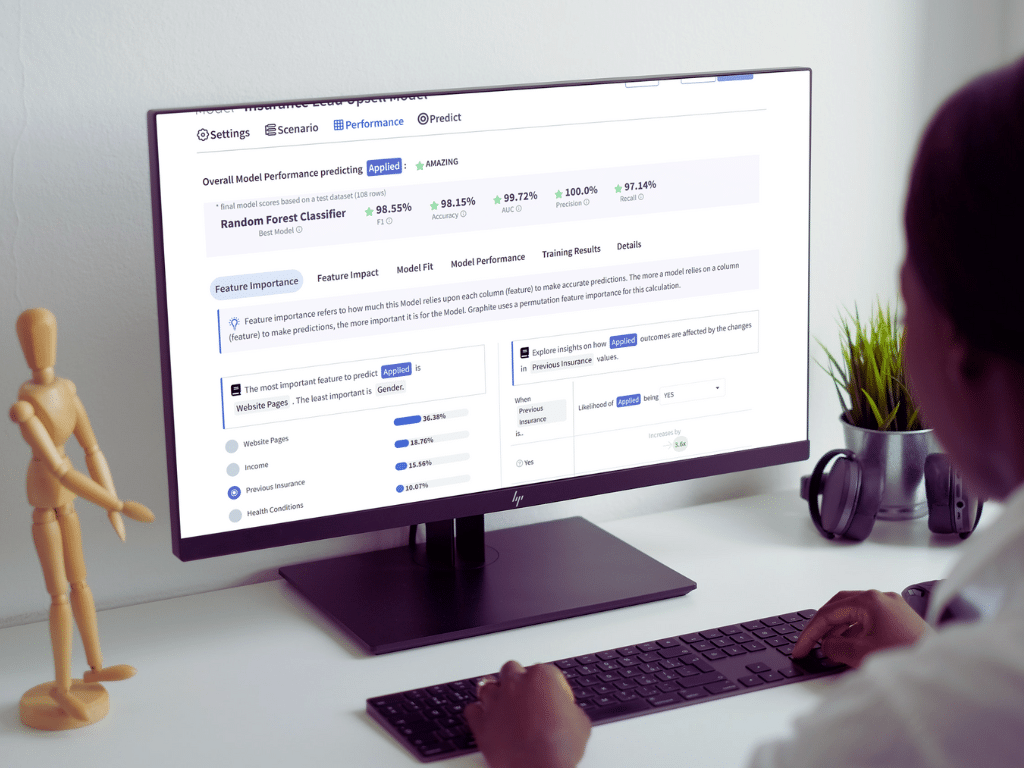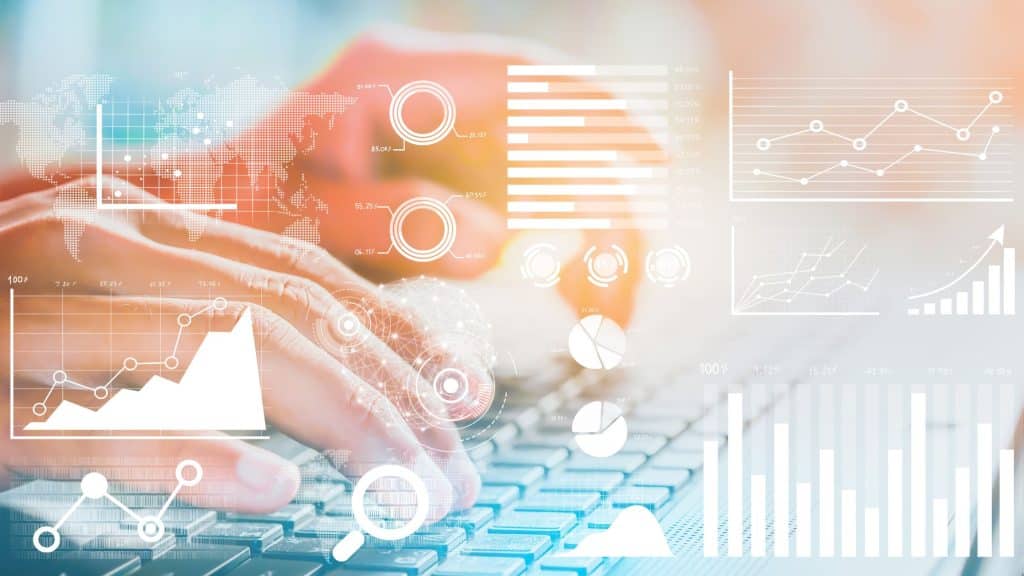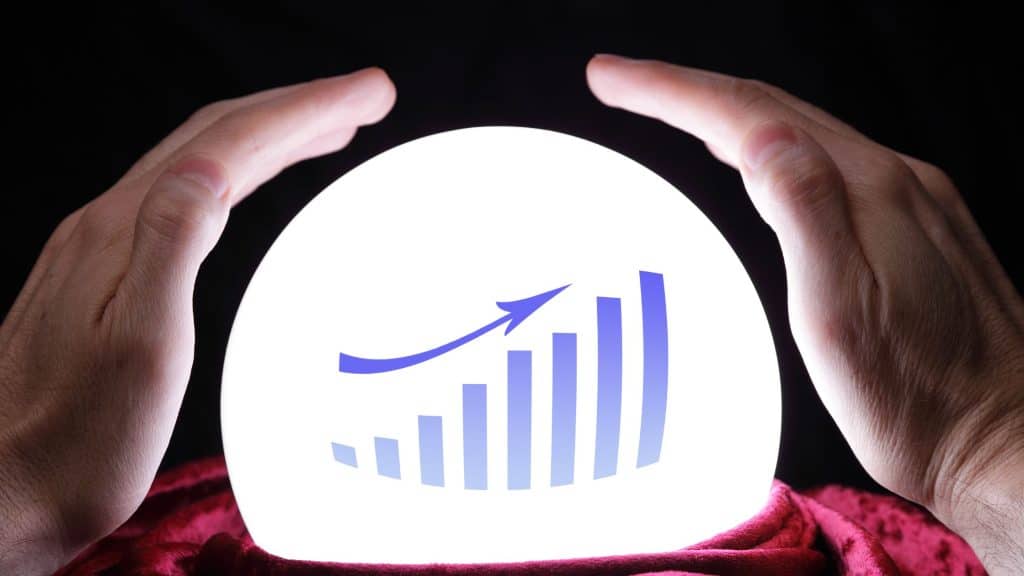Predictive analytics for business may seem daunting at first. Consider predictive analytics techniques as a compass led by your business data. Predictive analytics helps you make better informed decisions for your business.
What is Predictive Analytics?
Predictive analytics is a branch of data analysis. Predictive analytics tools use statistical techniques and machine learning algorithms to make predictions about future events. Predictive analytics uses historical data to identify patterns and trends. Your predictive analytics software then uses that information to make predictions about what will happen in the future. For example, you can analyze sales data from past seasons. This enables you to identify patterns and trends that can help you make an educated guess about what will sell well in the future. The predictive analytics definition may seem scientific, but predictive analytics algorithms can be used in a wide range of industries, including healthcare, finance, marketing, sales, operations, and manufacturing.

How Do Predictive Analytics Work?
Predictive analytics uses historical data, statistical algorithms, and machine learning techniques. Predictive analytics models make predictions about future outcomes. Businesses can make informed decisions and improve their overall performance. Predictive analysis enables businesses to use their data to gain a competitive edge. Organizations can make more informed decisions and remain one step ahead of their competitors. The predictive analytics process enables you to identify patterns and trends that might otherwise go unnoticed, and look out for potential future events. Your predictive analytics project helps you to discover hidden insights and make accurate predictions. This high level use of data analytics enhances your strategic planning and optimizes your operations. In healthcare, predictive analytics can be used to identify patients at risk of developing certain conditions. In finance, predictive analytics algorithms can be used to predict which customers are most likely to default on a loan. Predictive analytics can help businesses of all types make better decisions and stay ahead of the competition.
A Step-by-Step Guide to Predictive Analytics: Understanding the Process
Predictive analytics techniques look similar, but your outcomes and objectives will be different. The predictive analytics process encompasses three key steps:
1. Data Collection and Preparation: Predictive analytics is heavily dependent on data. The more data you collect, the better you can develop machine learning models. It is essential to gather and preprocess a wide range of relevant large data sets from various sources, ensuring that the data is accurate, complete, and suitable for analysis. This includes different types of data, such as internal data, external data, and any other relevant datasets. The collected data must be preprocessed to ensure it is clean and ready for analysis. To streamline the data collection and preparation process, organizations can utilize Graphite Note’s data integration capabilities. Graphite Note seamlessly integrates data from multiple sources, automates data cleaning and preprocessing tasks, and ensures the data is ready for analysis efficiently.
2. Model Building and Validation: Once the data is prepared, the next step is to build statistical models and algorithms. These models are trained on historical data and validated using various techniques to ensure their accuracy and reliability. This process involves selecting the appropriate algorithms, training the models on historical data, and validating their performance. Graphite Note’s no-code interface makes model building and validation accessible to users of all technical expertise levels. With a diverse range of machine learning algorithms and techniques, Graphite Note enables organizations to build robust predictive models without needing to write any code, eliminating the necessity for data science skills.
3. Deployment and Maintenance: The final step involves deploying the predictive models into production and continuously monitoring their performance. Regular maintenance and updates are crucial to keeping the models up-to-date and reliable. Graphite Note simplifies the deployment and maintenance process by allowing organizations to seamlessly integrate their predictive models into existing systems and workflows. Its user-friendly interface facilitates the monitoring and maintenance of models, ensuring smooth operations and reliable predictions.
Supervised, Unsupervised, and Reinforcement Learning: A Detailed Explanation for Non-technical Audiences
Predictive analytics is the process of using data, statistical algorithms, and machine learning techniques to identify the likelihood of future outcomes based on historical data. There are four main types of predictive analytics techniques:
Reinforcement learning: In reinforcement learning, the algorithm learns by interacting with an environment and receiving feedback in the form of rewards or penalties. Reinforcement learning is used in decision-making scenarios, including robotics and game play. For example, a reinforcement learning algorithm might be used to optimize an automated trading system or to control a self-driving car.
Supervised machine learning: In supervised learning, the algorithm is trained on a labeled dataset. Each training example is paired with an output label. The machine learning model learns to map inputs to the correct output. Supervised machine learning is used for tasks like classification and regression. For example, a supervised learning algorithm might be used to predict which customers are most likely to churn or to predict the likelihood of a customer buying a product.
Unsupervised machine learning: Unsupervised learning involves training the algorithm on data points that do not have labeled responses. The machine learning model tries to identify patterns and relationships in the data. Unsupervised machine learning is often used for clustering and association tasks. For example, an unsupervised learning algorithm might be used to segment customers into different groups based on their behavior or to find items that are frequently purchased together.
Semi-supervised machine learning: This method is a combination of supervised and unsupervised learning. Semi-supervised machine learning uses a small amount of labeled input data and a large amount of unlabeled data for training. This can improve learning accuracy when labeled data is scarce.
A Look at Use Cases for Supervised, Unsupervised, and Reinforcement Learning
Predictive analytics is a powerful tool for businesses, but it’s not a one-size-fits-all solution. Different types of predictive analytics can be used to solve various problems. In this part, we’ll take a closer look at the three main types of predictive analytics: supervised, unsupervised, and reinforcement learning, and explore the use cases for each.
Supervised learning is all about classification and regression problems. It’s like a teacher giving a student a test, then grading it based on the answers. In the same way, supervised learning algorithms are given a dataset with labeled examples and learn to predict the label of new, unseen examples. Use cases for supervised learning include:
- Fraud detection in financial transactions.
- Spam detection in email.
- Image recognition.
- Sales forecast.
- Predictive Customer Churn.
- Predictive Lead Scoring.
Unsupervised learning is focused on finding patterns in data that humans wouldn’t usually notice. It’s like a detective searching for clues at a crime scene. Unsupervised algorithms are given a dataset with no labels and must find structure in the data on their own.
Some use cases for unsupervised learning include:
- Clustering customer data to identify segments and build lead scoring models.
- Anomaly detection to identify unusual behavior in a system.
- Market basket analysis to identify items that are often purchased together.
Reinforcement learning is all about decision-making. It’s like a game player learning how to make the best move to win. Reinforcement learning algorithms learn to make decisions by receiving rewards or penalties for different actions. Some use cases for reinforcement learning include:
- Robotics and control systems.
- Game playing AI.
- Self-driving cars.
The Top Algorithms Used in Predictive Analytics
Predictive analytics is a powerful tool that allows businesses to make informed decisions about the future. At its core, it’s all about using data to identify patterns and predict what might happen next. Many different algorithms can be used for predictive analytics, each with its own strengths and weaknesses. The decision tree is one of the most popular algorithms for supervised learning, which is used for classification and regression problems. This algorithm is easy to understand and implement and works well with continuous and categorical data. Decision trees work by breaking down data into smaller and smaller subsets, making it easy to identify patterns and make predictions. Another popular algorithm for unsupervised learning, which is used for clustering and association rule mining, is k-means. This algorithm helps find clusters of similar data points, and it’s often used for customer segmentation and market research. K-means works by dividing data into a specified number of clusters and then iteratively reassigning data points to different clusters until they reach the optimal grouping. With the help of the decision tree, and k-means algorithms, it is easy to identify patterns and make predictions.
Why Predictive Analytics is Essential for Business Success
Predictive analytics empowers your business to make informed, data-driven decisions. Using predictive analytics models, you can anticipate future trends and take proactive measures before issues arise. This foresight enables you to optimize your operations and stay ahead of your competitors. Predictive analytics is used across a variety of fields. In agriculture, farmers can use predictive analytics to analyze historical weather patterns and data, creating accurate weather forecasts. This enables them to make data-driven decisions about planting and harvesting, ultimately increasing crop yields and reducing waste. Software companies can utilize predictive analytics to analyze lead data, such as demographics and website activity, to identify leads most likely to convert. By focusing sales efforts on these leads, companies can increase their conversion rates and overall sales efficiency. Predictive analytics helps you build a strategic advantage by:
- Building your Return on Investment (ROI): Predictive analytics removes guesswork from decision-making, allowing businesses to make faster, more accurate decisions. A survey of Fortune 500 companies revealed that those using predictive analytics saw a 5% increase in revenue and a 3% decrease in costs on average. Similarly, small businesses using predictive analytics techniques experienced a 6% revenue increase and a 4% cost reduction, leveling the playing field with larger competitors.
- Enhancing Efficiency: Predictive analytics can automate repetitive tasks, such as stock checks in warehouses, saving time and reducing human error. It also identifies operational bottlenecks, such as call center inefficiencies, allowing businesses to improve performance and customer satisfaction.
- Enabling Cost Savings: Retail giants and manufacturers have successfully used predictive analytics to optimize inventory and maintenance schedules, respectively. By predicting product demand and machine breakdowns, these businesses reduce costs and increase efficiency, leading to better resource utilization and quality control.
- Improving Supply Chain Management: Predictive analytics can forecast potential disruptions and delays, enabling businesses to mitigate risks and prevent costly downtime. By using data to negotiate better deals and improve logistics, companies can achieve significant cost savings.
- Improving Profitability and Customer Retention: Predictive analytics helps businesses optimize costs and improve profitability by identifying areas of excessive spending. Additionally, it can predict customer churn, allowing companies to retain at-risk customers through targeted interventions. For example, a telecommunications company reduced its churn rate by 15% by using predictive models to identify and engage at-risk customers.
Explore the Bright Future of Predictive Analytics and No-Code Tools
With no-code tools like Graphite Note, predictive analytics is becoming even more accessible to a broader range of companies. No-code predictive analytics software means your business can benefit from predictive analytics without needing a data science team. Sign up for a free trial of Graphite Note today and experience the benefits of predictive analytics firsthand.




